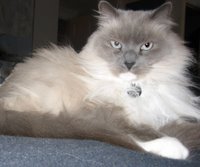Tuesday, March 28, 2006
Feline Legends: The Mythology of Cats
It's Tuesday, which Aloysius has declared the day of simply being cat. While he is doing that, I've been catching up on my reading.The Mythology of Cats:
Feline Legend and Lore through the Ages
By Gerald and Loretta Hausman
St. Martin's Press, 1998
The Mythology of Cats is an episodic guide to cats in popular culture, literature, myth, and folklore. From Mohammed's cat to Hemingway's, with many digressions along the way, the authors offer an impressionistic portrait of how humans have attached meaning to their beloved felines. Also included are portraits of various cat breeds, some of them obscure indeed.
Oddly, the authors concentrate on the relationship between men and cats, mentioning only a few female ailurophiles, such as Colette and Sylvia Townsend Warner. It's good to know that a manly guy like Jack Kerouac, though, was nuts about his cat Tyke.
The text owes much to Joseph Campbell's method of seeking archetypes, comparing ancient myths with later poems and stories and finding common threads.
The authors don't rely on reason, but on feeling, to prove the correspondences between various cat motifs. Using this way of thinking about the image of the cat, Edward Lear, usually categorized as a nonsense poet, becomes something else again. Take "The Owl and the Pussycat," a poem about the marriage between members of two species.
The owl and the pussycat went to seaThe authors suggest that, whether he knew it or not, Lear was invoking a classical myth in which the Goddess Athena turns into an owl, while Diana turns into a cat. (Never mind that both of these were female goddesses.) In a few pages, the authors also bring in American Indian references to cats and owls, as well as the ancient Egyptians' correlation of the cat and the sun and the owl and the moon.
In a beautiful pea-green boat.
They took some money
and plenty of honey
Wrapped up in a five-pound note.
Who knows whether Lear had all this in mind? Thinking in archetypes, it's not necessary that he did. The mind-patterns that are archetypes are supposed to be universal, a proof of our common humanity.
I wouldn't take this kind of argument by analogy seriously as scholarship, but it's fun to think about, isn't it?
Talking cats get a chapter, too. I found it strange that the authors think that the poem "Pangur Ban" was supposed to have been dictated by the cat, Pangur, to his monkish human. I think that Aloysius Katz' more recent rendition gets it right: the monk and the cat are each absorbed in their own pursuits.
Finally, I was pleased to see that this book dwells on the cat's image as a being who needs no outside reference. At the end of the chapter on the temple cat, the authors refer to the cat's Zen significance: the cat does not need to strive and to achieve. The cat just is.
Tags: catymology cats Book Review folklore


